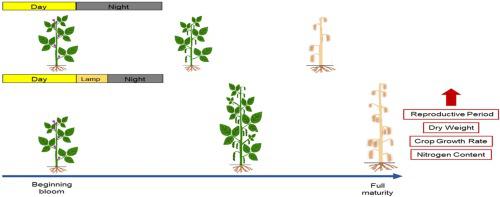Field Crops Research ( IF 5.6 ) Pub Date : 2021-02-26 , DOI: 10.1016/j.fcr.2021.108104 Santiago Julián Kelly , María Gabriela Cano , Diego Darío Fanello , Eduardo Alberto Tambussi , Juan José Guiamet

|
In soybeans, exposure to non-inductive photoperiods (i.e., long or extended days) after flowering triggers a number of responses, including slower development of reproductive structures, enhanced vegetative growth and increased production of flowers. The larger number of flowers under extended photoperiods results in an increase of the number of fruits, which eventually may translate into greater grain yield. The main goal of this work was to assess whether C and N assimilation rates increase in soybeans subjected to long days after flowering. Soybean cultivars NS4619 and NS5019 were planted in the field during the normal planting season in 2016−17 and 2018−19. At flowering, two treatments were imposed: natural (Nat) or extended photoperiods (Ext) in which daylength was prolonged by 4 h with low intensity illumination from light-emitting diode lamps delivering less than 10 μmol m−2 s−1 of photosynthetically active radiation at the top of the canopy.
Extended photoperiods prolonged reproductive growth, thereby delaying crop maturity. Growth of the main stem and branches was promoted by Ext, with plants showing greater number of nodes and main stem + branches dry weight at maturity. The number of pods and seeds increased by 69–87 % and 31–76 %, respectively, in Ext, and pod and seed dry weight increased significantly in 2016−17. Averaged over the whole reproductive period, crop growth rate increased under Ext in 2016−17 and 2018−2019. Ext promoted post-flowering vegetative growth more than growth of seeds, therefore harvest index was lower under Ext. The growth increase under Ext was larger if the biomass of abscised leaf blades and petioles was taken into account. Consistently with increased biomass under Ext, nitrogen accumulation by the crop was higher under extended photoperiods, with no dilution effect of N due to increased dry mass. About half of the N in plant tissues derived from biological nitrogen fixation, irrespective of photoperiodic condition, which implied that both, nitrogen fixation and uptake of soil nitrogen increased under long photoperiods. In brief, both the amounts of C and N assimilated by the crop were higher under Ext. Understanding the molecular, biochemical and physiological basis of post-flowering photoperiodic effects might offer clues to increase the yield potential of soybeans.
中文翻译:

花期延长后的光周期增加了中熟大豆品种的干物质生产和氮同化率
在大豆中,暴露于非感应光周期(即开花后(长或长天)会触发许多响应,包括生殖结构的发育变慢,营养生长增强和花的产量增加。在延长的光周期下,较大数量的花朵导致果实数量增加,最终可能转化为更高的谷物产量。这项工作的主要目的是评估开花后长日照大豆中碳和氮的同化率是否增加。在2016-17和2018-19的正常种植季节,在田间种植了大豆品种NS4619和NS5019。开花时进行了两种处理:自然(Nat)或延长的光周期(Ext),其中日光延长了4 h,而发光二极管灯发出的低强度照明则发出了小于10μmolm的光冠层顶部的-2 s -1光合有效辐射。
延长的光周期延长了生殖生长,从而延迟了作物的成熟期。Ext促进了主茎和枝条的生长,成熟时植株显示出更多的节数和主茎+枝干重。在Ext中,豆荚和种子的数量分别增加了69–87%和31–76%,在2016-17年度,豆荚和种子的干重显着增加。在整个生殖期平均,在Ext 2016-17和2018-2019年,农作物的增长率有所提高。Ext对花后营养生长的促进作用大于种子的生长,因此,Ext条件下的收获指数较低。如果考虑到无叶的叶片和叶柄的生物量,Ext下的生长增加更大。与Ext下生物量的增加一致,在延长的光周期下作物的氮积累量更高,由于增加了干燥质量而没有氮的稀释作用。不论光周期条件如何,植物组织中大约一半的N来自生物固氮,这表明在长光周期下固氮和土壤氮的吸收均增加。简而言之,在Ext下,作物吸收的C和N量均较高。了解开花后光周期作用的分子,生化和生理基础可能为提高大豆单产潜力提供线索。在Ext条件下,作物吸收的碳和氮量均较高。了解开花后光周期作用的分子,生化和生理基础可能为提高大豆单产潜力提供线索。在Ext条件下,作物吸收的碳和氮量均较高。了解开花后光周期作用的分子,生化和生理基础可能为提高大豆单产潜力提供线索。











































 京公网安备 11010802027423号
京公网安备 11010802027423号